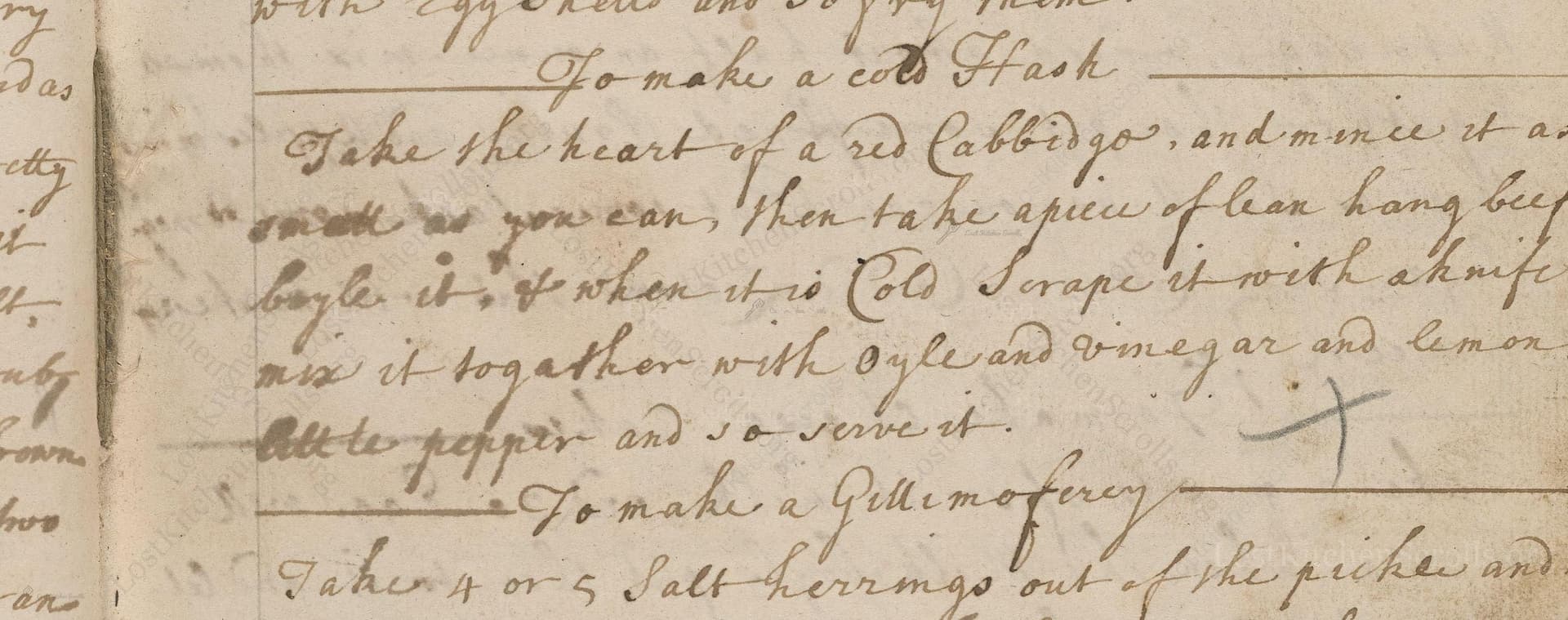To Make A Cold Hash
From the treasured pages of Receipt book of Dorothy Stone
Written by Dorothy Stone

To Make A Cold Hash
"Take the heart of a red Cabbage, and mince it as small as you can, then take a piece of lean hang beef, and Boyle it, if when it is Cold Scrape it with a knife and mix it togather with Oyle and Vineagar and lemon Jaice and pepper and so serve it."
Note on the Original Text
Early 18th-century recipes were more conversational and far less prescriptive than those of today. Quantities and precise instructions were rarely stated because many cooks were assumed to be experienced or managing with what was available. Spellings were not yet standardized ('Boyle' for 'boil', for example), and the phrasing was less formal—'scrape it with a knife' rather than shred or slice. Instructions were typically brief, direct, and left to the cook’s own judgement, making such recipes both flexible and creatively open-ended.

Title
Receipt book of Dorothy Stone (1725)
You can also click the book image above to peruse the original tome
Writer
Dorothy Stone
Era
1725
Publisher
Unknown
Background
Step into the delicious world of early 18th-century kitchens with Dorothy Stone, where classic recipes and culinary curiosities await. Expect a charming medley of hearty fare, sweet treats, and the tasteful secrets of a bygone era.
Kindly made available by
Folger Shakespeare Library
This recipe originates from the early 18th century, specifically around 1725, attributed to Dorothy Stone, a writer whose recipes reflect the emergence of lighter, refreshingly tart dishes in the diet of upper-middle-class households. At this time, England was influenced by continental European traditions, incorporating pickled, cured, and fresh flavors into salads and cold preparations. Hang beef refers to salted, air-dried cured meat that would have kept well before refrigeration, a staple for cold dishes in manor kitchens—this cold hash is essentially an early, frugal, and delicious salad reinventing leftovers into a vibrant dish.

Cooks in the 1720s would have used a heavy kitchen knife or a long-bladed chopping knife to mince the cabbage and a sturdy butcher’s knife for scraping the cooked beef. A large wooden trencher or chopping board would have been used for the preparation. Mixing was done in earthenware or pewter bowls, and dressing the salad involved simply tossing it together by hand or with large spoons.
Prep Time
15 mins
Cook Time
20 mins
Servings
2
We've done our best to adapt this historical recipe for modern kitchens, but some details may still need refinement. We warmly welcome feedback from fellow cooks and culinary historians — your insights support the entire community!
Ingredients
- 1 small red cabbage heart (approx. 9 oz)
- 3.5 oz lean cured beef (sub: lean pastrami or corned beef)
- 2 tablespoons olive oil
- 1 tablespoon white wine vinegar or apple cider vinegar
- Juice of 1/2 lemon
- Freshly ground black pepper
Instructions
- Start by taking the firm heart of a red cabbage and chopping it as finely as possible—aim for a fine mince, almost like you would for a slaw.
- Next, take about 3.5 ounces of lean cured beef (a good equivalent today might be lean pastrami or corned beef).
- Boil the beef until tender, then let it cool completely.
- Once cooled, use a sharp knife to scrape or finely shred the beef.
- In a bowl, mix the minced cabbage with the shredded beef.
- Dress this with about 2 tablespoons of good-quality olive oil, 1 tablespoon white wine vinegar (or apple cider vinegar), the juice of half a lemon, and a generous grind of black pepper.
- Toss well and serve chilled or at room temperature.
Estimated Calories
140 per serving
Cooking Estimates
Preparing this salad takes about 15 minutes, including chopping the cabbage and shredding the beef. The beef needs to be boiled, which takes about 20 minutes. Each serving contains around 140 calories. This recipe makes 2 servings.
As noted above, we have made our best effort to translate and adapt this historical recipe for modern kitchens, taking into account ingredients nowadays, cooking techniques, measurements, and so on. However, historical recipes often contain assumptions that require interpretation.
We'd love for anyone to help improve these adaptations. Community contributions are highly welcome. If you have suggestions, corrections, or cooking tips based on your experience with this recipe, please share them below.
Join the Discussion
Rate This Recipe
Dietary Preference
Main Ingredients
Occasions

Den Bockfisch In Einer Fleisch Suppen Zu Kochen
This recipe hails from a German manuscript cookbook compiled in 1696, a time whe...

Die Grieß Nudlen Zumachen
This recipe comes from a rather mysterious manuscript cookbook, penned anonymous...

Ein Boudain
This recipe comes from an anonymous German-language manuscript cookbook from 169...

Ein Gesaltzen Citroni
This recipe, dating from 1696, comes from an extensive anonymous German cookbook...
Browse our complete collection of time-honored recipes



